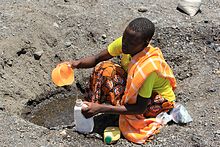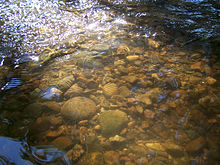
Back قاع المجرى Arabic Йырҙа Bashkir Vaga BAT-SMG Рэчышча Byelorussian Рачное рэчышча BE-X-OLD Речно корито Bulgarian Naoz Breton Llit fluvial Catalan Dno toku Czech Юхлăх CV
This article needs additional citations for verification. (February 2017) |

A streambed or stream bed is the bottom of a stream or river (bathymetry) and is confined within a channel, or the banks of the waterway.[1] Usually, the bed does not contain terrestrial (land) vegetation and instead supports different types of aquatic vegetation (aquatic plant), depending on the type of streambed material and water velocity. Streambeds are what would be left once a stream is no longer in existence. The beds are usually well preserved even if they get buried because the banks and canyons made by the stream are typically hard, although soft sand and debris often fill the bed. Dry, buried streambeds can actually be underground water pockets.[1] During times of rain, sandy streambeds can soak up and retain water, even during dry seasons, keeping the water table close enough to the surface to be obtainable by local people.[1]

The nature of any streambed is always a function of the flow dynamics and the local geologic materials. The climate of an area will determine the amount of precipitation a stream receives and therefore the amount of water flowing over the streambed. A streambed is usually a mix of particle sizes which depends on the water velocity and the materials introduced from upstream and from the watershed. Particle sizes can range from very fine silts and clays to large cobbles and boulders (grain size). In general, sands move most easily, and particles become more difficult to move as they increase in size. Silts and clays, although smaller than sands, can sometimes stick together, making them harder to move along the streambed.[2] In streams with a gravel bed, the larger grain sizes are usually on the bed surface with finer grain sizes below. This is called armoring of the streambed.[2][3][4]

The streambed is very complex in terms of erosion and deposition. As the water flows downstream, different sized particles get sorted to different parts of a streambed as water velocity changes and sediment is transported, eroded and deposited on the streambed.[5] Deposition usually occurs on the inside of curves, where water velocity slows, and erosion occurs on the outside of stream curves, where velocity is higher.[2] This continued erosion and deposition of sediment tends to create meanders of the stream. In streams with a low to moderate grade, deeper, slower water pools (stream pools) and faster shallow water riffles often form as the stream meanders downhill. Pools can also form as water rushes over or around obstructions in the waterway.[2]
Under certain conditions a river can branch from one streambed to multiple streambeds.[2] For example, an anabranch may form when a section of stream or river goes around a small island and then rejoins the main channel. The buildup of sediment on a streambed may cause a channel to be abandoned in favor of a new one (avulsion (river)). A braided river may form as small threads come and go within a main channel.[6]
- ^ a b c "Below sandy, dry riverbeds: A medicine against drought". www.un-ihe.org. Retrieved 2023-06-08.
- ^ a b c d e Allan, David (2009). Stream Ecology: Structure and Function of Running Waters (2nd ed.). Dordrecht, The Netherlands: Springer. pp. |pages=36-43. ISBN 9781402055829.
- ^ Whiting, Peter J.; King, John G. (2003). "Surface particle sizes on armoured gravel streambeds: Effects of supply and hydraulics". Earth Surface Processes and Landforms. 28 (13): 1459–1471. Bibcode:2003ESPL...28.1459W. doi:10.1002/esp.1049.
- ^ Wilcock, Peter R.; DeTemple, Brendan T. (2005). "Persistence of armor layers in gravel-bed streams". Geophysical Research Letters. 32 (8). Bibcode:2005GeoRL..32.8402W. doi:10.1029/2004GL021772. ISSN 0094-8276.
- ^ Garcia, Marcelo; Parker, Gary (1991). "Entrainment of Bed Sediment into Suspension". Journal of Hydraulic Engineering. 117 (4): 414–435. doi:10.1061/(asce)0733-9429(1991)117:4(414).
- ^ Jerolmack, Douglas J.; Mohrig, David (2007). "Conditions for branching in depositional rivers". Geology. 35 (5): 463. Bibcode:2007Geo....35..463J. doi:10.1130/G23308A.1. ISSN 0091-7613.